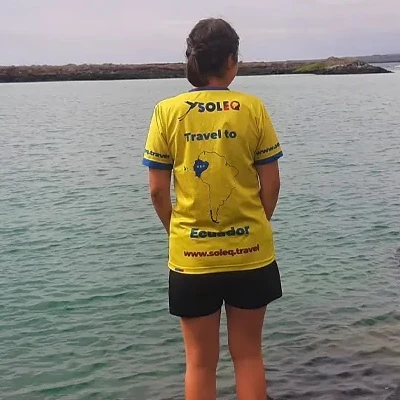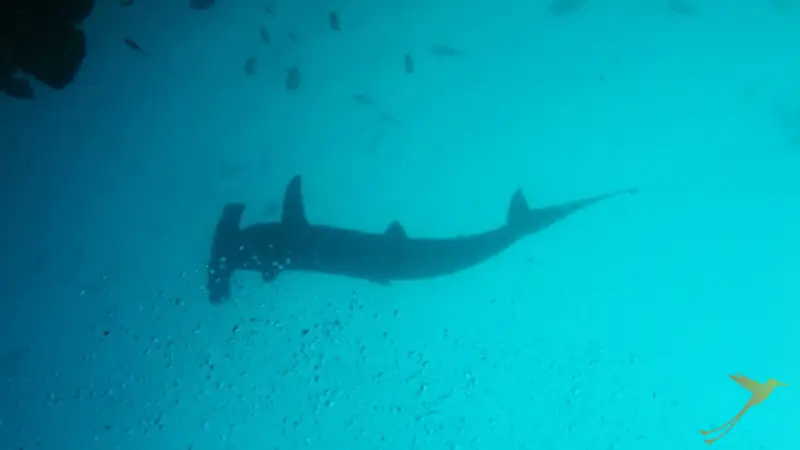
The Galápagos Islands are considered Ecuador’s paradise, and not without reason! Warm sunshine, white sandy beaches, clear seawater and diverse plant species that bloom all year round. Animals that enrich and make unique both the overwater world and the underwater world! One of these underwater animals is the hammerhead shark. This fish, known for its shape and named after it, is also native to the Pacific Ocean of the Galápagos National Park.
The Galápagos hammerhead shark is not uncommon near the archipelago, often several hundred specimens can be spotted at the same time. They are unmistakably recognizable by their hammer-shaped head. The eyes are located on the outer sides of the “hammer”, which serves for a better visibility. In contrast to the white underside of the hammerhead shark, the upper side of the body is gray silver. In general, the body of this shark species is slender and is perfect for swimming with the current. Hammerheads have teeth in the shape of backward triangles, which are perfect for hunting. In addition, hammerhead sharks have the hunting technique of turning 360 degrees at lightning speed. For this reason, they can surprise and catch their unsuspecting prey. In addition, hammerhead sharks have electrical sensors that help them hunt. With the help of these sensors, they can sense and smell prey, making it easier to track other animals.
Baby sharks are about 50 cm long, while adult specimens can reach a length of more than 4 meters. Sharks are generally harmless to humans. Worldwide, there is no known fatality caused by a hammerhead shark. To survive, the animals require a constant flow of water. They draw oxygen from the water into their bodies and breathe through their gills. On land, they can only survive for two minutes, then they suffocate.

Habitat, diet and reproduction
Endangerment
Galápagos hammerhead sharks are listed as critically endangered on the IUCN Red List. Because of the high value of their fins, they are often hunted by illegal fishers for sale on the Asian market. Fortunately, the Galápagos Marine Reserve is a safe place for hammerhead sharks and other marine animals, as fishing of protected species is illegal and strictly controlled. However, the animals have no protection when they leave the safe waters. Therefore, the Charles Darwin Foundation recently tagged 15 pregnant hammerhead sharks to better track their movements and provide better protection along their birth paths in the future.
Do you also want to visit the Galápagos Islands on your trip to Ecuador to see animals like hammerhead sharks, marine iguanas, or the Galápagos giant tortoises with your own eyes? We are looking forward to showing you the “islands that inspire” in the way you want to see them. Generally, it is possible to travel to the islands on cruise ships. If you prefer a cheaper alternative, you can also look for our last-minute offers or go island hopping. With island hopping you stay on the islands of Santa Cruz, Isabela or San Cristóbal and travel to other islands during day trips. We will be happy to advise you on various travel options and activities.
This shark species can be seen all year round, but most likely in the months of December to April in the extreme northwest of the archipelago near Darwin and Wolf islands. They can also be seen off Santa Cruz near Seymour, on San Cristóbal at Kicker Rock, which is also called Leon Dormido, and on Genovesa in Darwin Bay. Hammerheads feed mainly on smaller fish species such as sardines, herring or mackerel and occasionally hunt stingrays, squid or crustaceans. To reproduce, male specimens bite females until they surrender, at which point fertilization occurs. After a gestation period of 9 to 12 months, female hammerhead sharks give birth to dozens of babies at a time, which are born ready to swim. The mother leaves them in shallow coastal waters, where they find food and shelter. The baby sharks are in need of protection because they can be eaten by other adult sharks and predators, for this reason shallow waters are a good place to retreat as their predators are in the open ocean. If you are lucky, you can swim and snorkel with baby hammerhead sharks in a bay next to the beach “Tortuga Bay” on Santa Cruz. You can also join snorkeling and diving tours where you can observe the animals in the Pacific Ocean. When the hammerhead sharks are big enough after one or two years, they are ready to fend for themselves in the open ocean and leave the shallow waters.







